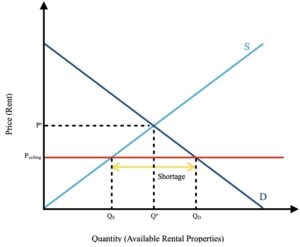Orange County is facing a lawsuit from The Florida Apartment Association and the Florida Association of Realtors over its decision to add a rent control proposal to the 2022 November ballot. The proposal, which aims to selectively cap rent increases for a year, is the latest revival of the classic price-control method policymakers have used to stabilize the prices of amenities and goods. Rent control places limits (or price “ceilings”) on the amount a landlord may charge a tenant for rent. While rent control has historically been promoted to improve housing affordability for low-income families, its unintended consequences tend to harm the very families it aims to assist.
Despite well-documented negative effects of rent control—and a Florida statute that restricts its practice within the state—some state lawmakers and local commissioners are pushing for its revival. With the cost of housing rapidly increasing within the Sunshine State, policymakers must focus on reducing barriers to housing market entry for developers. This approach would increase the housing supply and thus reduce costs for inhabitants rather than exacerbate the crisis using the same counteractive initiatives that have failed in the past. Rent control has proved to cause a multiplicity of adverse effects, including decreased affordability, gentrification, and an increase in the migration of urban issues into suburbs. Problems that rent regulation aims to fix end up becoming amplified.
The practice of capping rent prices has a long history within the United States and continues to incite debate among lawmakers. Amongst economists, however, the policy is not very popular because it merely imposes a price ceiling on the housing market. As demonstrated by the fundamental supply/demand model pictured below, a price ceiling creates an imbalance between the quantity of supplied housing and the quantity of demanded housing. In other words, the amount of individuals/families seeking rent-controlled units exceeds the number of rent-controlled units available in a given area, causing a shortage in affordable housing. Price ceilings create the illusion of lower rent prices, but only a select few benefit from such a policy.

Affordable housing shortages encouraged by rent control occur because landlords are unable to charge rent prices that would otherwise prevail under an area’s housing market equilibrium. Rent control incentivizes—or financially forces— them to sell, demolish, or convert their rental properties to recover their losses. This is what economists Rebecca Diamond, Timothy McQuade, and Franklin Qian found when examining the effect of rent control policies on San Francisco’s housing market from 1990 to 2016. Like Florida, the city of San Francisco had been experiencing high housing costs, and its local officials sought to relieve this by implementing rent control policies. Diamond and her colleagues reported a 15% decrease in the supply of rental housing caused by these laws and noted a city-wide rent increase of 5.1% due to the reduction of overall housing supply. These affordable housing shortages displace many low-income families from their communities, which can have detrimental impacts on their health, transportation options, and education access.
There are ways that lawmakers can effectively address Florida’s housing and cost-of-living crises without stalling the housing market and displacing communities. One avenue would be to ease zoning and land-use regulations in high-demand areas. These laws, which regulate everything from the size and use of land to historic preservation requirements, can be costly and daunting for developers to comply with. Strict zoning laws are proven to make new development close to impossible. In fact, “in nearly every major U.S. city, apartments are banned in at least 70 percent of residential areas.” Such laws deter—or prevent—new housing development, thus stagnating supply and causing housing costs to rise. These high costs are passed down to tenants in the form of higher rent and outprice many households from their communities.
In removing tedious zoning and land-use provisions, Florida’s state and local governments would drastically reduce the barriers of entry for housing developers. The result is increased housing construction within high-demand areas and decreased rent prices for residents. Additionally, tax breaks could incentivize owners of single-family residences to turn their homes and properties into multi-family dwellings. This would also work to increase the supply of properties available for rent.
The high housing costs experienced throughout the Sunshine State are a result of a skyrocketing demand for housing, exacerbated by unprecedented migration patterns. This has prompted many state lawmakers, like those in Orange County, to propose a classic price-control restraint on rents to “stabilize” affordable housing options. However, this outdated method of placing a price ceiling on rental rates will not fix the housing crisis but merely create further imbalances within the state’s housing market. As seen in its previous implementations, rent control decreases the number of properties available for rent and displaces the families it intends to help. Instead of repeating a historic mistake, Florida lawmakers should take steps to reduce tedious barriers of entry—such as unnecessary zoning and land-use laws—to increase the supply of housing. This way, housing supply will be able to satisfy high housing demand and reduce the cost of living for all Florida residents.
Mason Robinson is a fourth-year economics student at Florida State University and is currently serving as a policy intern at The James Madison Institute.
Chloe Kauffman is a third-year economics Student at Florida State University and is currently serving as a policy & communications intern at The James Madison Institute.











